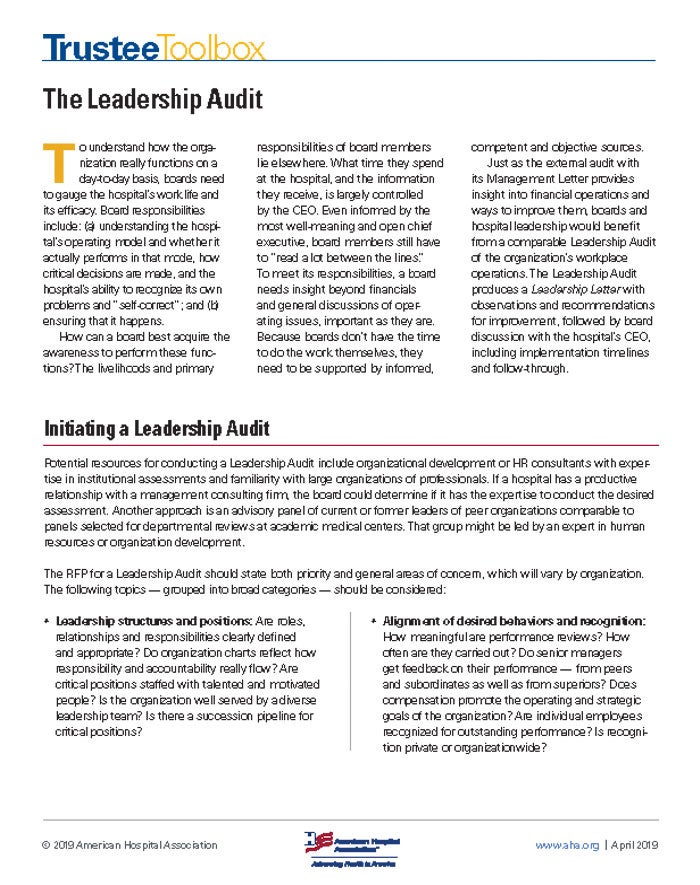
Transforming Governance
Board Oversight of Culture for High-Performing Hospitals
Leadership can learn from an informed, objective audit to improve management practices and processes
By Mitchell T. Rabkin, M.D. and Susan Y. Friedman
Governance
How does your hospital board know it is meeting its full responsibilities? Is the board doing its job with only a limited view into how the organization actually operates?
“Good board members monitor, guide and enable good management; they do not do it themselves,” writes Lesley Rosenthal, general counsel of Lincoln Center for the Performing Arts (https://corpgov.law.harvard.edu/2012/04/15/nonprofit-corporate-governance-the-boards-role), adding that good governance includes forming strategic policies and goals; authorizing major transactions; overseeing viability of the organization’s business model, integrity of its internal systems and controls, and accuracy of its financial statements; stewarding the organization’s resources; mentoring senior management; and evaluating operations.
Trustee Talking Points
- Culture is the result of leadership decisions shaping policies, processes and procedures, and how seriously these are internalized throughout the organization.
- To understand how the organization really functions on a day-to-day basis, a board needs insight beyond financials and general discussions of operating issues.
- The board and hospital leadership would benefit from an independent audit of the organization’s work life and its efficacy.
- However, the audit should emphasize continuous improvement rather than serve as a performance review.
But how do boards “monitor, guide and enable good management” and evaluate operations without actually stepping into a management role? An effective board requires a chair who sets appropriate agendas and leads. It also needs committed, skilled members unafraid to ask difficult questions of each other, the CEO and his/her team in an open environment.
Understandably, boards tend to focus on their fiduciary role, being well supported in doing so. Beyond appraisal of financial reports, the board, via its audit committee, reviews the external auditor’s detailed report and its “Management Letter.” Not a performance review of the CFO, the Management Letter offers recommendations to improve the hospital’s financial operations and reporting processes. A good board reviews these recommendations with the CFO, considers his or her responses, and monitors implementation of agreed-upon changes.
While this fiduciary lens on the hospital’s activities is critical, another vital perspective does not get the board attention it deserves. To quote from a “Report of the NACD Blue Ribbon Commission on Culture as a Corporate Asset” of the National Association of Corporate Directors, “If values are about the ‘what and why’ of an organization, then culture is the ‘how,’ the way in which those values are lived on a day-to-day basis.” While some may feel culture to be a dubious aspect of an organization, it is the result of leadership decisions shaping policies, processes and procedures, and how seriously these are internalized throughout the organization.
One could list spectacular cases of management misbehavior that slipped by board oversight. We focus on less flashy but more prevalent indicators of deeper issues that reflect organizational culture, such as:
- excessive turnover because of poor management (if not at the C-suite, then at lower levels);
- unenforced or inadequate personnel policies;
- unclear description of roles or relationships;
- gender discrimination;
- lack of openness;
- poor reception or handling of complaints by employees or patients; and so forth.
These situations lead to low morale, inefficiency, costly re-work, loss of talented staff, customer loss, sagging reputation as a place to work, and patients’ diminished expectations of technical quality of care and human concern. The result: underperforming human assets critical for the hospital’s overall health. Even with the hospital performing well, as defined by financial metrics, ineffective management of human assets can threaten its future financial performance. Focusing on human capital must be an important element of an organization’s strategy and its achievement.
To understand how the organization really functions on a day-to-day basis, boards need to gauge the hospital’s work life and its efficacy. Board responsibilities include: (a) understanding the hospital’s operating model (and whether it actually performs in that mode), how critical decisions are made, and the hospital’s ability to recognize its own problems and “self-correct”; and (b) ensuring that it happens.
How can a board best acquire the awareness to perform these functions? The livelihoods and primary responsibilities of board members lie elsewhere. What time they spend at the hospital, and the information they receive, is largely controlled by the CEO. Even informed by the most well-meaning and open chief executive, board members still have to “read a lot between the lines.” To meet its responsibilities, a board needs insight beyond financials and general discussions of operating issues, important as they are. Because boards don’t have the time to do the work themselves, they need to be supported by informed, competent and objective sources.
Just as the external audit with its Management Letter provides insight into financial operations and ways to improve them, boards and hospital leadership would benefit from a comparable audit of the organization’s workplace operations, producing a Leadership Letter with observations and recommendations for improvement, followed by board discussion with the hospital’s CEO, including implementation timelines and follow-through. (For further details, see Friedman SY and Rabkin MT, “Where Hospital Boards Often Fail: Auditing Leadership Performance,” in Academic Medicine 2018;93:1613-1616.)
Trustee Takeaways
- A Leadership Letter is an objective audit of workplace operations conducted by knowledgeable resources beyond the hospital.
- The Letter provides the board and CEO with an informed assessment for understanding and improving the hospital’s operations.
- The board uses the Letter’s observations and recommendations as a learning experience shared by the CEO and senior management.
- Open and positive discussion should address implementation timelines and plans for follow-through.
This external review would evaluate topics such as leadership style and effectiveness, staff expertise, transparency, appropriateness of operating metrics and their relation to strategy and stated goals. Using three years as a general recommendation, the interval between reviews is flexible. Organizational changes typically do not evolve quickly. Shorter intervals may make sense in response to unusual events, such as a new CEO or a merger or acquisition. Knowledgeable resources beyond the hospital — consultants, executives engaged elsewhere, others — could perform a leadership audit.
A process model for such an audit has been employed for periodic departmental reviews at academic medical centers by external experts. In those settings, the process is not a performance review of the department head; rather, it serves as honest inquiry and evaluation shared with the department head, hospital director and medical school dean, offering comments and recommendations to bolster the department’s capabilities. The end is constructive, at times even adding justification to the department’s requests for hospital/medical school support for improvement and growth.
Nor is the Leadership Letter a CEO performance review. Like the external auditor’s Management Letter, it is an informed external assessment for the CEO, other managers and the board to become aware of, monitor and improve hospital operations. Just as the Management Letter is appropriate for virtually all organizations — nonprofit and for-profit — so too is the Leadership Letter. A CEO might argue that his or her personal assessment of the organization suffices, but the primary goal of the letter is to add another perspective to that of the board and CEO. Surely any CFO ignoring the external auditor’s Management Letter would not be tolerated by the board. And any CEO should recognize the helpful benefit of the Leadership Letter.

